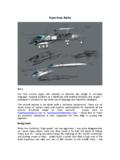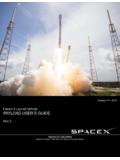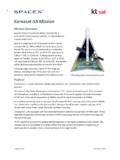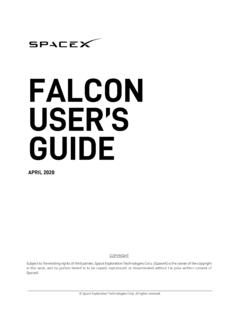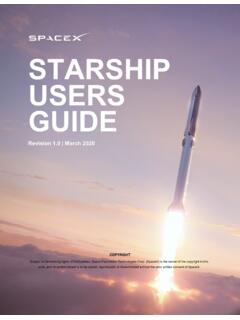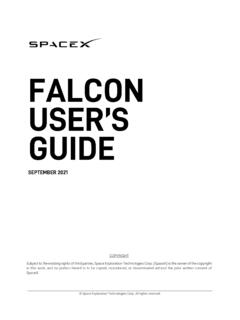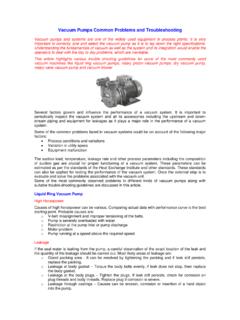Transcription of This documet is an abridged transcript of Elon Musk’s ...
1 abridged transcript 9/28/2017 SpaceX 2017 LIFE MULTIPLANETARY You want to wake up in the morning and think the future is going to be great - and that s what being a spacefaring civilization is all about. It s about believing in the future and thinking that the future will be better than the past. And I can t think of anything more exciting than going out there and being among the stars. Elon Musk, CEO and Lead Designer, SpaceXBECOMING A MULTI-PLANET SPECIESThis presentation will cover the updated design for what we are currently calling BFR. The most important thing that I want to convey in this presentation is that I think we have figured out how to pay for it. This is very important. In last year s presentation, we were really searching for the right way to pay for this thing. We went through various ideas Kickstarter, collecting underpants, etc. These didn t pan out, but now we think we have got a way to achieve updated design leverages a smaller vehicle, still pretty big but a single vehicle that can do everything that s needed for greater Earth orbit activity.
2 Essentially we want to make our current vehicles redundant. We want to have one system one booster and one ship that replaces Falcon 9, Falcon Heavy and Dragon. If we can do that, then all the resources that are used for Falcon 9, Falcon Heavy and Dragon can be applied to this system. That s really fundamental. PROGRESSDEEP CRYO LIQUID OXYGEN TANK This giant deep cryo liquid oxygen tank is actually a twelve meter tank you can see the relative scale of it in figure 1. It s a thousand cubic meters of volume inside. That is actually more pressurized volume than an A380, to put that into perspective. We developed a new carbon fiber matrix that is much stronger and more capable at cryo than anything before, and it holds 1200 tons of liquid oxygen. We successfully tested the tank up to its design pressure and then went a little further. We wanted to see where it would break, and we succeeded in that effort.
3 It shot about 300 feet into the air, landed in the ocean and we fished it out. At this point we have got a pretty good sense of what it takes to create a huge carbon fiber tank that can hold cryogenic liquid. That is actually extremely important for making a light ENGINE TESTINGThe next key element is on the engine side. We have to have an extremely efficient engine; the Raptor engine will be the highest thrust-to-weight engine, we believe, of any engine of any kind ever made. We already have 1200 seconds of firing across 42 main engine tests. We have fired Raptor for as long as 100 seconds. It could fire for much longer than 100 seconds, this is just a reflection of the size of the test tanks. The duration of the firing for landing on Mars is about 40 seconds. The test engine currently operates at 200 atmospheres, or 200 bar, the flight engine will be at 250 bar, and then we believe over time we could probably get that to a little over 300 Deep cryo liquid oxygen tank developed by SpaceXThis documet is an abridged transcript of Elon Musk s presentation at the 68th International Astronautical Congress on September 28th, 2017 in Adelaide, LIFE MULTIPLANETARY abridged transcript 9/28/2017 SpaceX 2017 PROPULSIVE LANDINGThe next key element is propulsive landing.
4 In order to land on a place like the Moon where there is no atmosphere and certainly no runways, or to land on Mars where the atmosphere is too thin to land with wings even if there were runways, you really have to get propulsive landing perfect. Propulsive landing is what we have been practicing with Falcon 9. As of the time of this presentation, SpaceX has had 16 successful landings and that is really without any redundancy. Falcon 9 s final landing is always done with a single engine whereas with BFR, we will always have multi-engine out capability. You want minimum pucker factor on landing you need to be able to essentially count on the landing. If you can get to a very high reliability with even a single engine, and then you can land with either of two engines, I think we can get to a landing reliability that is on par with the safest commercial airliners. Falcon 9 can also land with very high precision.
5 In fact, we believe the precision at this point is good enough that we will not need legs for the next version. It will literally land with so much precision that it will land back on its launch RATEWhen you seriously consider the idea of establishing a self-sustaining base on Mars or the Moon or elsewhere, you ultimately need thousands of ships and tens of thousands of refilling operations. This means you need many launches per day. In terms of how many landings are occurring, you need to be looking at your watch, not your calendar. So while SpaceX s launch rate is quite high by conventional standards, it is still a very small launch rate compared to what will ultimately be needed. RENDEZVOUS AND DOCKINGThe next key technology is automated rendezvous and docking. In order to refill the spaceship in orbit, you have to be able to rendezvous and dock with the spaceship with very high precision and transfer propellant.
6 That is one of things that we have perfected with Dragon. Dragon 1 will do an automated rendezvous and docking without any pilot control to the space station. Dragon 1 currently uses the Canadarm for the final placement onto the space station. Dragon 2, which launches next year, will not need Falcon 9 completing a successful propulsive Launch rate to date and projected 2017/2018 MAKING LIFE MULTIPLANETARY abridged transcript 9/28/2017 SpaceX 2017 use the Canadarm as it will directly dock with the space station, and it can do so with zero human intervention. You just press go and it will has also allowed us to perfect heat shield technology. When you enter at a high velocity, you will melt almost anything. The reason meteors do not reach Earth is they melt or disintegrate before they reach the ground, unless they are very big. You have to have a sophisticated heat shield technology that can withstand unbelievably high temperatures and that is what we have been perfecting with Dragon also a key part of any planet colonizing system.
7 VEHICLE EVOLUTIONFALCON 1 Falcon 1 is where we started out. A lot of people really only heard of SpaceX relatively recently, so they may think Falcon 9 and Dragon just instantly appeared and that s how it always was but it wasn t. We started off with just a few people who really didn t know how to make rockets. And the reason that I ended up being the chief engineer or chief designer, was not because I wanted to, it s because I couldn t hire anyone. Nobody good would join, I ended up being that by default. And I messed up the first three launches, the first three launches failed. Fortunately the fourth launch which was the last money that we had for Falcon 1 the fourth launch worked, or that would have been it for SpaceX. But fate liked us that day. So the fourth launch worked and it s interesting today is the ninth anniversary of that launch. I didn t realize that until I was told that just earlier today but this is a very emotional day, actually.
8 Falcon 1 was quite a small rocket. When we were doing Falcon 1 we were really trying to figure out, What is the smallest useful payload that we could get to orbit? We thought, okay, something that could launch around half a ton to low Earth orbit. And that is how we sized Falcon 1, but it is really quite small compared to Falcon 9 Falcon 9, particularly when you factor in payload, is roughly on the order of thirty times more payload than Falcon 1. And Falcon 9 has reuse of the primary booster , which is the most expensive part of the rocket. Hopefully, Falcon 9 will soon have reuse of the fairing, the big nose cone at the front. We think we can probably get to somewhere between 70 and 80 percent reusability with the Falcon 9 system. FALCON HEAVYH opefully, towards the end this year we will be launching Falcon Heavy. Falcon Heavy ended up being a much more complex program than we thought. It sounds like Falcon Heavy should be easy because it s two Falcon 9 first stages strapped onto a center first stage as boosters.
9 It is actually not easy. We had to redesign almost everything except the upper stage in order to take the increased loads. Falcon Heavy ended up being much more a new vehicle than we realized, so it took us a lot longer to get it done, but the boosters have all now been tested and they are on their way to Cape Canaveral. And we are now beginning serious development of Vehicle overview: Falcon 1, Falcon 9, Falcon Heavy and BFRMAKING LIFE MULTIPLANETARY abridged transcript 9/28/2017 SpaceX 2017 From figure 5, you can see that the payload difference between BFR and the other vehicles is quite dramatic. With BFR in fully reusable configuration, without any orbital refueling, we expect to have a payload capability of 150 tons to low Earth orbit. That compares to about 30 tons for Falcon Heavy, which is partially reusable. Where this really makes a tremendous difference is in the cost, which will be discussed later in the presentation.
10 With BFR, you can get a sense of scale by looking at the tiny person in the image below. It is really quite a big vehicle. Main body diameter is about 9 meters or 30 feet and the booster is lifted by 31 Raptor engines that produce a thrust of about 5,400 tons, lifting the 4,400 ton vehicle straight SHIP OVERVIEWThe ship is 48 meters in length. Dry mass is expected to be about 85 tons. Technically, our design says 75 tons but inevitably there will be mass growth. The ship will contain 1,100 tons of propellant with an ascent design of 150 tons and return mass of 50 tons. You can think of this as essentially combining the upper stage of the rocket with Dragon it is as if the Falcon 9 upper stage and Dragon were figure 7, you have the engine section in the rear, the propellant tanks in the middle and then a large payload bay in the front. That payload bay is actually eight stories tall. In fact, you can fit a whole stack of Falcon 1 rockets in the payload bay.
